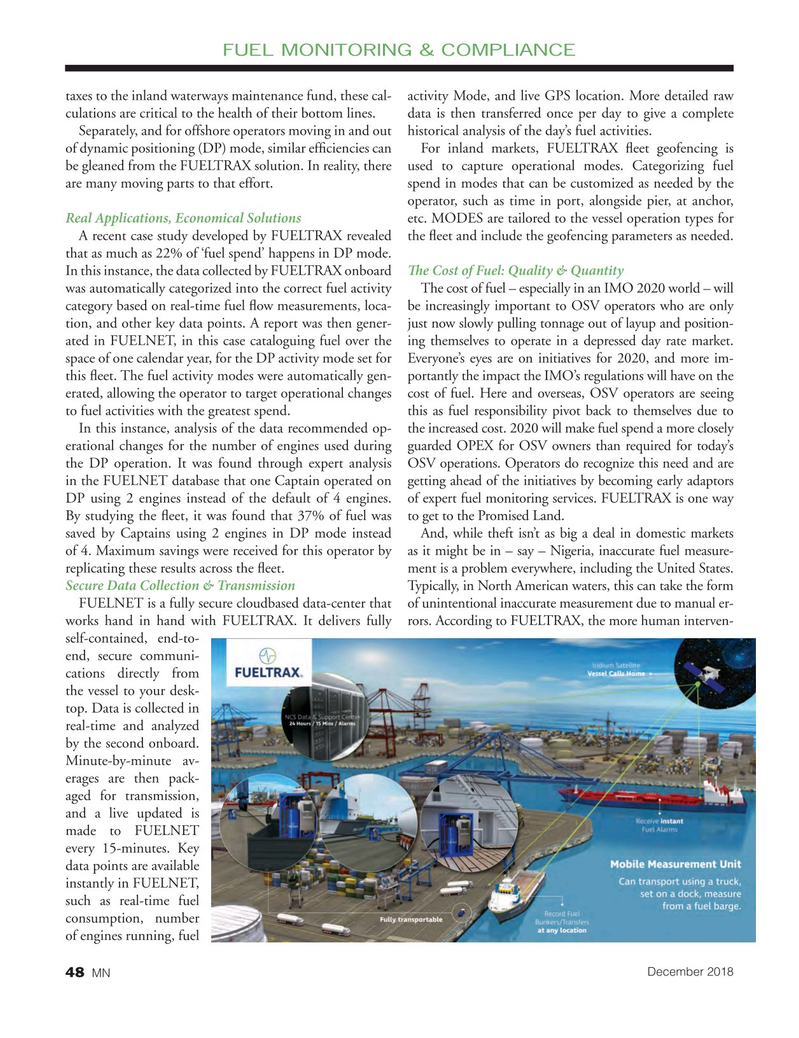
Page 48: of Marine News Magazine (December 2018)
Innovative Products & Boats
Read this page in Pdf, Flash or Html5 edition of December 2018 Marine News Magazine
FUEL MONITORING & COMPLIANCE taxes to the inland waterways maintenance fund, these cal- activity Mode, and live GPS location. More detailed raw culations are critical to the health of their bottom lines. data is then transferred once per day to give a complete
Separately, and for offshore operators moving in and out historical analysis of the day’s fuel activities. of dynamic positioning (DP) mode, similar ef? ciencies can For inland markets, FUELTRAX ? eet geofencing is be gleaned from the FUELTRAX solution. In reality, there used to capture operational modes. Categorizing fuel are many moving parts to that effort. spend in modes that can be customized as needed by the operator, such as time in port, alongside pier, at anchor,
Real Applications, Economical Solutions etc. MODES are tailored to the vessel operation types for
A recent case study developed by FUELTRAX revealed the ? eet and include the geofencing parameters as needed. that as much as 22% of ‘fuel spend’ happens in DP mode.
In this instance, the data collected by FUELTRAX onboard T e Cost of Fuel: Quality & Quantity was automatically categorized into the correct fuel activity The cost of fuel – especially in an IMO 2020 world – will category based on real-time fuel ? ow measurements, loca- be increasingly important to OSV operators who are only tion, and other key data points. A report was then gener- just now slowly pulling tonnage out of layup and position- ated in FUELNET, in this case cataloguing fuel over the ing themselves to operate in a depressed day rate market. space of one calendar year, for the DP activity mode set for Everyone’s eyes are on initiatives for 2020, and more im- this ? eet. The fuel activity modes were automatically gen- portantly the impact the IMO’s regulations will have on the erated, allowing the operator to target operational changes cost of fuel. Here and overseas, OSV operators are seeing to fuel activities with the greatest spend. this as fuel responsibility pivot back to themselves due to
In this instance, analysis of the data recommended op- the increased cost. 2020 will make fuel spend a more closely erational changes for the number of engines used during guarded OPEX for OSV owners than required for today’s the DP operation. It was found through expert analysis OSV operations. Operators do recognize this need and are in the FUELNET database that one Captain operated on getting ahead of the initiatives by becoming early adaptors
DP using 2 engines instead of the default of 4 engines. of expert fuel monitoring services. FUELTRAX is one way
By studying the ? eet, it was found that 37% of fuel was to get to the Promised Land.
saved by Captains using 2 engines in DP mode instead And, while theft isn’t as big a deal in domestic markets of 4. Maximum savings were received for this operator by as it might be in – say – Nigeria, inaccurate fuel measure- replicating these results across the ? eet. ment is a problem everywhere, including the United States.
Secure Data Collection & Transmission Typically, in North American waters, this can take the form
FUELNET is a fully secure cloudbased data-center that of unintentional inaccurate measurement due to manual er- works hand in hand with FUELTRAX. It delivers fully rors. According to FUELTRAX, the more human interven- self-contained, end-to- end, secure communi- cations directly from the vessel to your desk- top. Data is collected in real-time and analyzed by the second onboard.
Minute-by-minute av- erages are then pack- aged for transmission, and a live updated is made to FUELNET every 15-minutes. Key data points are available instantly in FUELNET, such as real-time fuel consumption, number of engines running, fuel
December 2018 48 MN
MN Dec18 Layout 32-49.indd 48 MN Dec18 Layout 32-49.indd 48 11/21/2018 11:10:16 AM11/21/2018 11:10:16 AM

 47
47

 49
49
